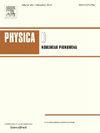Perturbation and determinacy of nonsmooth systems
IF 2.7
3区 数学
Q1 MATHEMATICS, APPLIED
引用次数: 0
Abstract
Take a system where several variables (for ) cause decision states to be set independently to values , at any instant, and the outcome then affects how each evolves according to a differential equation. We show here that the probability that the system lies in a given decision state at any instant cannot be determined solely from these differential equations, but is determined by the emergence of a dynamical attractor. Moreover this attractor is sensitive to small perturbations in how the decisions are enacted, and even how the system’s evolution is calculated. If the probability that decides ‘’ is and decides ‘’ is , for instance, the probability that decides ‘’ and decides ‘’ at any moment is not generally , despite the independence of their decisions (nor is it any other determinable quantity such as ). Only certain weighted sums of probabilities of being in different decision states are determined by the logic of the system.
This result comes from formulating this simple decision-making scenario as a dynamical system with discontinuities (or piecewise-smooth or nonsmooth system), and exposes a need to better understand the indeterminacy of discontinuous models, and how they behave under perturbation. The perturbations of interest might represent physical properties neglected in an idealised model with discontinuities, or imperfections introduced in simulations, perhaps by discretising the system, by smoothing out a discontinuity, or delaying a discontinuity’s effect on the system.
We define concepts here that permit us to characterise the determinacy of discontinuous systems and compare them under such perturbations. We find that although the overall dynamics of a system is indeterminable at a discontinuity, certain measures of occupancy either side of a discontinuity are determinable. These give a refined insight into Filippov’s differential inclusions, and give more precision to Utkin’s notion of equivalent dynamics, interestingly allowing us to treat discontinuities in dynamical systems similarly to Markov processes.
非光滑系统的摄动与确定性
以一个系统为例,其中几个变量xi(对于i=1,2,…)导致决策状态hi在任何时刻被独立地设置为值Ai,然后结果会影响每个xi如何根据微分方程演变。我们在这里表明,系统在任何时刻处于给定决策状态的概率不能仅仅由这些微分方程决定,而是由动态吸引子的出现决定的。此外,这个吸引子对如何制定决策,甚至如何计算系统演化的小扰动都很敏感。例如,如果x1决定‘ A1 ’的概率是P(A1), x2决定‘ A2 ’的概率是P(A2),那么x1决定‘ A1 ’和x2决定‘ A2 ’在任何时刻的概率通常不是P(A1)P(A2),尽管它们的决定是独立的(也不是任何其他可确定的量,如P(A1)P(A2|A1))。系统的逻辑决定了处于不同决策状态的概率的加权和。这个结果来自于将这个简单的决策场景表述为一个具有不连续(或分段光滑或非光滑系统)的动力系统,并暴露出需要更好地理解不连续模型的不确定性,以及它们在扰动下的行为。感兴趣的扰动可能代表在具有不连续的理想模型中被忽略的物理特性,或在模拟中引入的缺陷,可能是通过离散系统,通过平滑不连续或延迟不连续对系统的影响。我们在这里定义了一些概念,使我们能够描述不连续系统的确定性,并在这种扰动下对它们进行比较。我们发现,虽然系统的总体动力学在不连续点上是不可确定的,但在不连续点两侧的某些占位量是可确定的。这给菲利波夫的微分包含提供了一个精辟的见解,并使Utkin的等效动力学概念更加精确,有趣的是,允许我们像对待马尔可夫过程一样对待动力系统中的不连续。
本文章由计算机程序翻译,如有差异,请以英文原文为准。
求助全文
约1分钟内获得全文
求助全文
来源期刊

Physica D: Nonlinear Phenomena
物理-物理:数学物理
CiteScore
7.30
自引率
7.50%
发文量
213
审稿时长
65 days
期刊介绍:
Physica D (Nonlinear Phenomena) publishes research and review articles reporting on experimental and theoretical works, techniques and ideas that advance the understanding of nonlinear phenomena. Topics encompass wave motion in physical, chemical and biological systems; physical or biological phenomena governed by nonlinear field equations, including hydrodynamics and turbulence; pattern formation and cooperative phenomena; instability, bifurcations, chaos, and space-time disorder; integrable/Hamiltonian systems; asymptotic analysis and, more generally, mathematical methods for nonlinear systems.
 求助内容:
求助内容: 应助结果提醒方式:
应助结果提醒方式:


